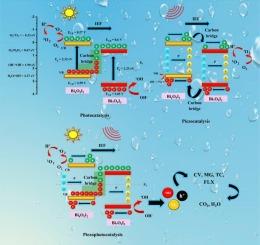创新设计的Bi4O5l2/Bi7O9I3-C复合材料,用于LED辐射和超声功率下增强压电催化处理彩色和无色污染物
IF 4.7
3区 化学
Q2 CHEMISTRY, PHYSICAL
Journal of Photochemistry and Photobiology A-chemistry
Pub Date : 2025-08-22
DOI:10.1016/j.jphotochem.2025.116717
引用次数: 0
摘要
本文介绍了一种超声辅助湿浸渍法制备Bi4O5l2/Bi7O9I3-C复合材料的新方法。采用XRD、FTIR、SEM、TEM、BET、UV-Vis DRS、PL和EIS等强大的表征手段对三元异质结及其组分进行了鉴定。制备Bi4O5l2/Bi7O9I3-C异质结可以显著提高压电和光催化性能。在Bi4O5l2/Bi7O9I3中加入碳纳米颗粒,提高了复合材料的导电性,缩小了带隙,扩大了光利用率。测试了Bi4O5l2/Bi7O9I3-C对结晶紫(CV)、孔雀石绿(MG)、四环素(TC)、左氧氟沙星(LFX)等彩色和无色有机污染物的压催化、光催化和压催化活性。Bi4O5l2/Bi7O9I3-C对CV、MG、TC和LFX的去除率分别为97.5%、100%、91.3%和94.4%,在短时间内(40 min)表现出强大的光催化处理能力。一级动力学结果表明,Bi4O5l2/Bi7O9I3-C的压光催化效果分别是单一压电催化和光催化的5.36倍和1.67倍。压电力、光照射和Z-scheme电荷模式的综合作用使电荷分离速度加快,电荷产生增强,价带电位呈正态,从而增强了压电光催化性能。最终,我们的研究鼓励了铋基催化剂在压电催化领域的应用,以提高降解效率,缩短污染物降解时间。本文章由计算机程序翻译,如有差异,请以英文原文为准。

Innovative design of Bi4O5l2/Bi7O9I3-C composites for reinforced piezophotocatalytic treatment of color and colorless pollutants under LED radiation and ultrasonic power
This work introduces a novel fabrication of Bi4O5l2/Bi7O9I3-C composites via the ultrasonic-assisted wet impregnation strategy. Robust characterizations, such as XRD, FTIR, SEM, TEM, BET, UV–Vis DRS, PL, and EIS, were employed to identify the ternary heterojunction and its components. Developing Bi4O5l2/Bi7O9I3-C heterojunction could significantly boost piezoelectric and photocatalytic properties. The light utilization was expanded by incorporating carbon nanoparticles into Bi4O5l2/Bi7O9I3, which promotes electrical conductivity and narrows the band gap of composites. The piezocatalytic, photocatalytic, and piezophotocatalytic activity of Bi4O5l2/Bi7O9I3-C was tested for the degradation of color and colorless organic pollutants, like crystal violet (CV), malachite green (MG), tetracycline (TC), and levofloxacin (LFX). The Bi4O5l2/Bi7O9I3-C showed powerful piezophotocatalytic treatment in a short time (40 min) with removal efficiencies of 97.5 %, 100 %, 91.3 %, and 94.4 % against CV, MG, TC, and LFX, respectively. The first-order kinetics revealed the superiority of piezophotocatalytic efforts of Bi4O5l2/Bi7O9I3-C, which is 5.36 and 1.67 times greater than sole piezocatalytic and photocatalytic, respectively. The integrated work of piezoelectric force, light irradiation, and Z-scheme charge mode exhibited rapid charge separation, boosted charge generation, and positive valence band potential, resulting in enhanced piezophotocatalytic performance. Ultimately, our study encourages the employment of Bi-based catalysts in piezophotocatalytic fields to improve the degradation efficiency and reduce the pollutant degradation time.
求助全文
通过发布文献求助,成功后即可免费获取论文全文。
去求助
来源期刊
CiteScore
7.90
自引率
7.00%
发文量
580
审稿时长
48 days
期刊介绍:
JPPA publishes the results of fundamental studies on all aspects of chemical phenomena induced by interactions between light and molecules/matter of all kinds.
All systems capable of being described at the molecular or integrated multimolecular level are appropriate for the journal. This includes all molecular chemical species as well as biomolecular, supramolecular, polymer and other macromolecular systems, as well as solid state photochemistry. In addition, the journal publishes studies of semiconductor and other photoactive organic and inorganic materials, photocatalysis (organic, inorganic, supramolecular and superconductor).
The scope includes condensed and gas phase photochemistry, as well as synchrotron radiation chemistry. A broad range of processes and techniques in photochemistry are covered such as light induced energy, electron and proton transfer; nonlinear photochemical behavior; mechanistic investigation of photochemical reactions and identification of the products of photochemical reactions; quantum yield determinations and measurements of rate constants for primary and secondary photochemical processes; steady-state and time-resolved emission, ultrafast spectroscopic methods, single molecule spectroscopy, time resolved X-ray diffraction, luminescence microscopy, and scattering spectroscopy applied to photochemistry. Papers in emerging and applied areas such as luminescent sensors, electroluminescence, solar energy conversion, atmospheric photochemistry, environmental remediation, and related photocatalytic chemistry are also welcome.

 求助内容:
求助内容: 应助结果提醒方式:
应助结果提醒方式:


